Fannie Mae’s May economic forecast calls for multifamily housing starts to decline through the end of 2024 before slowly recovering in 2025 despite persistently high interest rates. Single-family housing starts are expected to rise but at a lower rate than predicted last month.
Fannie Mae’s forecasters are predicting that the Federal Reserve will leave the Fed Funds rate unchanged at 5.3 percent until Q4 2024 and then will cut to a rate of 5.0 percent. This is unchanged from last month’s forecast. However, they are now expecting the Fed Funds rate to fall to only 4.8 percent by the end of 2025. Last month’s forecast predicted that the rate would drop to 4.1 percent by then.
The 10-year Treasury is predicted to rise to 4.6 percent in Q2 2024 and remain at or above that level through the end of 2025.
Fewer multifamily starts expected
The current forecast for multifamily housing starts is shown in the first chart, below, along with three other recent forecasts. Fannie Mae considers any building containing more than one dwelling unit to be “multifamily”, including both condominiums and rental housing units.
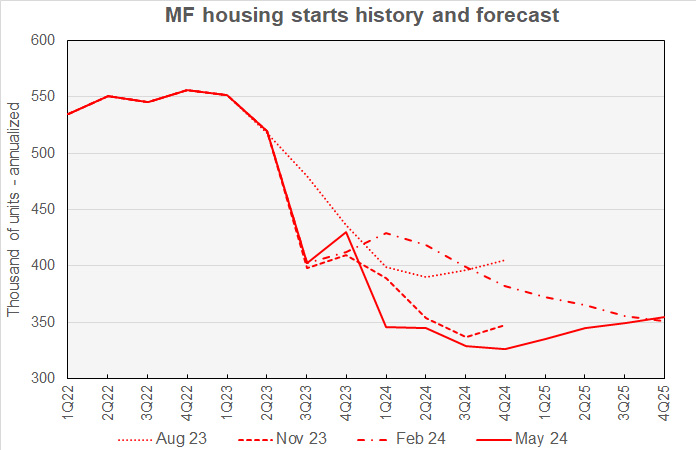
The multifamily starts forecast was again revised lower from last month’s levels. The number of starts forecasted for every quarter of 2024 and 2025 was lowered by 15,000 or more annualized units. The largest revision was a decrease of 42,000 annualized unit starts predicted for Q2 2024.
The current forecast calls for multifamily starts to fall from 346,000 annualized units in Q1 2024 to a low of 326,000 annualized units in Q4 2024. Multifamily starts are then predicted to rise slowly through the end of 2025, finishing the year at a rate of 355,000 annualized units.
For reference, the most recent New Residential Construction report from the Census Bureau has multifamily starts running at an annualized rate of 343,000 units in Q1 2024.
Looking at yearly forecasts, the predicted number of multifamily starts for 2024 was revised lower by 37,000 units to 336,000 units. The forecast for multifamily starts in 2025 was revised lower by 19,000 units to 346,000 units.
Single-family starts forecast revised lower
The current forecast for single-family housing starts is shown in the next chart, below, along with three other recent forecasts.
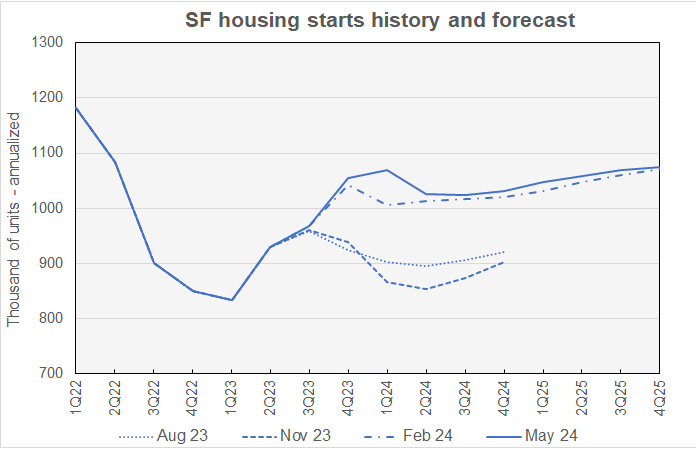
As with the multifamily forecast, the revisions to the single-family starts forecast in each quarter call for fewer starts than did last month’s forecast. The Q1 2024 forecast was revised lower by 1,000 annualized units while every subsequent quarterly forecast was revised lower by a larger amount. The revision to the Q4 2025 forecast was for 38,000 fewer annualized starts.
The number of single-family starts is forecast to fall from 1,069,000 annualized units in Q1 2024 to a low of 1,024,000 annualized units in Q3 2024. Single-family starts are then forecast to rise gradually, reaching 1,075,000 annualized units in Q4 2025.
Looking at full-year predictions, Fannie Mae now expects single-family starts to be 1,038,000 units in 2024, down 13,000 units from the level forecast last month. Single-family starts in 2025 are forecast to be 1,063,000 units, down 36,000 units from the level forecast last month.
Higher GDP growth expected
The next chart, below, shows Fannie Mae’s current forecast for Gross Domestic Product (GDP) growth, along with other recent forecasts.
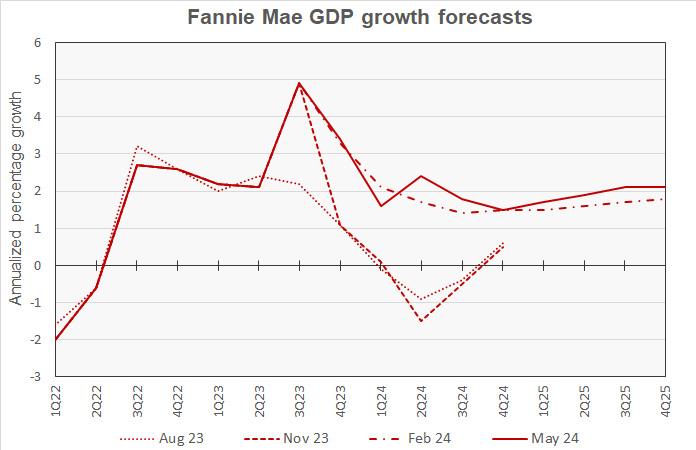
Fannie Mae’s forecasters revised their estimate for Q1 2024 GDP growth lower from 2.4 percent to 1.6 percent, matching the Bureau of Economic Analysis’ advance estimate for Q1. However, Fannie Mae then revised their forecast for Q2 2024 GDP higher from 1.8 percent to 2.4 percent. Other revisions to the quarterly GDP estimates in this month’s forecast were relatively small, with only one revision being as high as 0.2 percentage points.
The full year forecasts for GDP growth for 2024 and 2025 were each unchanged at 1.8 percent and 1.9 percent respectively.
CPI Inflation predicted higher later
The next chart, below, shows Fannie Mae’s current forecast for the Consumer Price Index (CPI), along with three other recent forecasts.
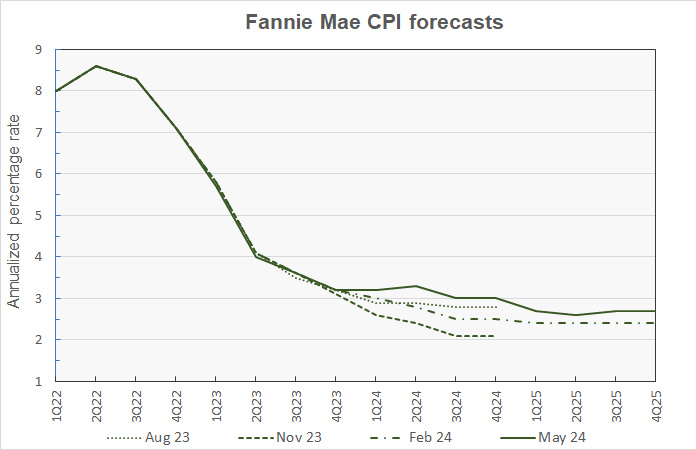
Fannie Mae’s CPI inflation quarterly forecasts were revised lower for Q2 2024 through Q1 2025. As is usually the case, the revisions were small with only the Q3 2024 forecast revision being as large as 0.2 percentage points. Revisions to the CPI forecasts for the last 3 quarters of 2025 were all 0.1 percentage point to the upside.
Looking at whole-year projections, the forecast for year-over-year CPI inflation in Q4 2024 was lowered 0.1 percentage points to 3.0 percent. The Q4 2025 year-over-year inflation forecast was raised 0.1 percentage points to 2.7 percent.
Employment growth forecast higher
The next chart, below, shows Fannie Mae’s current forecast for the employment growth, along with three earlier forecasts. Employment growth is our preferred employment metric since job gains, along with productivity gains, drive economic growth. By contrast, the unemployment rate depends on employment but also on the labor force participation rate. Either rising employment or falling labor force participation can drive the unemployment rate lower, but only the former would contribute to economic growth.
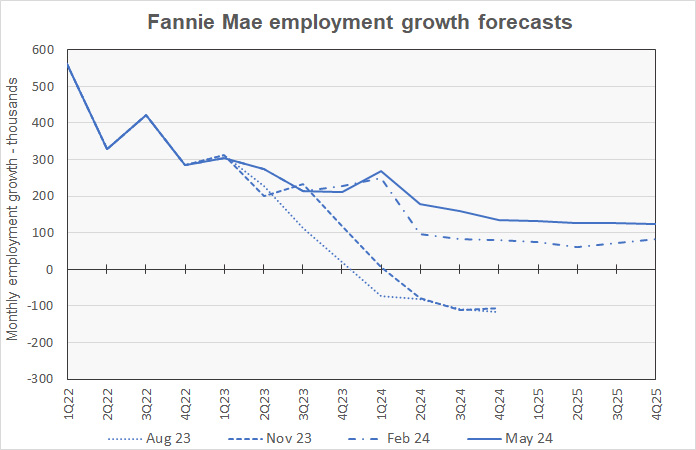
After a slight reduction from prior forecasts for Q1 and Q2 2024, Fannie Mae foresees higher employment growth through the end of 2025. Q1 2024 is predicted to have the strongest employment growth with an average monthly gain of 269,000 jobs. Employment growth is predicted to fall over the rest of the forecast period, reaching a rate of 123,000 jobs per month in Q4 2025.
For reference, the Employment Situation Report from the Bureau of Labor Statistics indicates that the economy added an average of 269,000 jobs per month in Q1 2024.
Compared to last month’s forecast, the expected full year forecast for employment growth in 2024 was revised from a gain of 2,100,000 jobs to a gain of 2,200,000 jobs. The employment growth forecast for 2025 was revised significantly higher, rising from 800,000 added jobs to 1,500,000 added jobs.
The Fannie Mae May forecast can be found here. There are links on that page to the detailed forecasts and to the monthly commentary.













